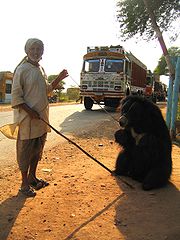- Tame bear
-
A tame bear, often called a dancing bear, is a wild bear that is captured when the animal is young, though some of them are born and bred in captivity. In some parts of the world, such as South Asia and the Middle East, people still use them for road side tourist attractions.
Contents
History
There exists evidence[citation needed] of various peoples taming bears in the Indus Valley Civilization. Statues of bears[citation needed] suggest that they used them for entertainment purposes. Romani have been known to tame bears since the Middle Ages up until the end of the 14th century. This practice continues in places such as India, Bulgaria, and Siberia. Their acts are criticised by some Westerners, especially animal rights advocates such as PETA[1]
India
Indian gypsies poach Sloth Bear cubs from jungles and train them to dance for people. They would put a nose ring and a metal muzzle on the bear's snout, which are attached to a staff. The staff is then used to manipulate the bear, causing it to simulate a dance.[citation needed] Wildlife officers confiscated adult bears and cubs to send them to rescue centres located across India. The largest centre, which is open to the public, is in Agra. As of December 2009, officials have freed all of the remaining dancing bears.[2]
The Middle East
Gypsies from Saudi Arabia poached Syrian Brown Bear cubs from mountainous regions of Syria, Turkey, Afghanistan, Iran, and Iraq. The tradition ended because of Islamic custom and belief.
Siberia
Siberian tribal peoples capture cubs for use as dancing bears. This practice continues to this day.
Europe
Dancing bears were a common sight in Europe during the Middle Ages. All of Europe had dancing bears during the 13th century. The practice began fading in Western Europe by the 15th century, but remained alive in Eastern Europe. Dancing bears were commonly seen in Bern, Switzerland. The depiction of a dancing bear occurs in the oldest known city seal (1224)[citation needed], and living bears have been kept in Bern at the town's expense since 1513 (except for a brief interval when the French removed them to Paris in 1799.5).[citation needed] Dancing bears were also a common feature at traditional winter festivals in Poland throughout the 18th century.
See also
References
- ^ https://secure.peta.org/site/Advocacy?cmd=display&page=UserAction&id=897
- ^ BBC News Last Indian dancing bear set free Collected 18 Dec 2009
External links
- http://www.wildlifesos.org/IBR/ABRF/ABRF.htm Agra Bear Rescue Facility
- http://www.internationalanimalrescue.org/projects/9/Bear+rescue+and+rehabilitation.html Dancing bear rescue and rehabilitation
- http://www.wspa-usa.org/pages/2171_dancing_bears.cfm
- http://blip.tv/file/3282941 Video footage about the last dancing bear in Bulgaria
Categories:
Wikimedia Foundation. 2010.

